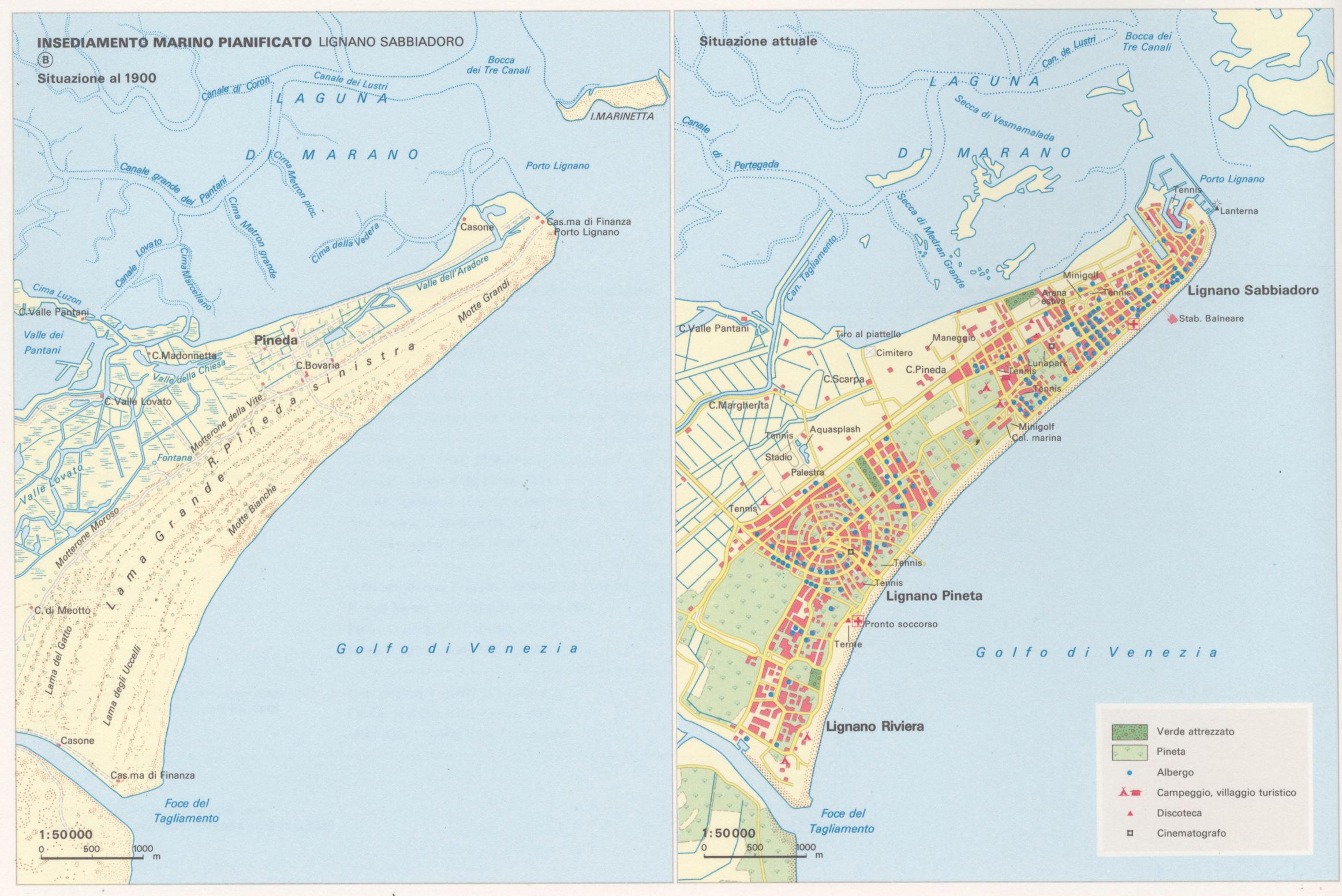Lignano Sabbiadoro Historical Map 1900 and Today


David Chen
Data Visualization Specialist
David Chen is an expert in transforming complex geographic datasets into compelling visual narratives. He combines his background in computer science ...
Geographic Analysis
What This Map Shows
The map titled "Lignano Sabbiadoro in 1900 and today" presents a striking visual juxtaposition of this popular Italian seaside resort town's development over more than a century. On the left side, we see Lignano as it was in 1900, characterized by its modest coastal layout, sparse infrastructure, and a smaller population. In contrast, the right side showcases the contemporary landscape, highlighting extensive urbanization, a bustling beachfront, and a network of roads and facilities catering to tourists and residents alike.
However, this visualization is not just about the aesthetic changes; it represents the broader themes of urban development, tourism trends, and environmental impacts that have shaped Lignano Sabbiadoro into the vibrant destination it is today.
Deep Dive into Urban Development and Tourism
Lignano Sabbiadoro, located in the Friuli Venezia Giulia region of Italy, has seen transformative growth since the early 20th century. In 1900, it was a relatively obscure area, mostly known for its natural beauty and tranquil beaches. The region was largely agricultural, with few permanent structures and a very low population density. According to historical records, the population was just a few hundred people, primarily engaged in fishing and farming.
Fast forward to the present, and Lignano has evolved into a major tourist hub, attracting millions of visitors each year. The population swelled to approximately 6,000 residents, but during the summer months, this number can increase to over 100,000, thanks to an influx of tourists. What's fascinating is how this spike in population has influenced local economies, infrastructure, and the environment.
The rise of tourism in Lignano can be traced back to the post-World War II era when increased leisure time and economic prosperity led to a boom in seaside vacations. The construction of hotels, restaurants, and recreational facilities began in earnest during the 1960s and 1970s. Today, you’ll find a wide array of accommodations, from luxury hotels to budget-friendly hostels, catering to diverse visitors. In fact, the tourism sector now accounts for over 70% of the local economy.
However, this rapid development hasn’t come without challenges. Urban sprawl has significantly altered the natural landscape, raising concerns about environmental sustainability. Coastal erosion, habitat loss, and increased waste generation are pressing issues that Lignano faces today. Interestingly, local authorities have begun implementing eco-friendly initiatives aimed at balancing growth with environmental stewardship, such as promoting sustainable tourism and protecting coastal ecosystems.
Regional Analysis
When examining the historical and contemporary maps of Lignano Sabbiadoro, it’s important to consider how its development compares to nearby coastal towns like Bibione and Caorle. Each of these locations has experienced growth, but Lignano stands out due to its unique geographical advantages and proactive urban planning.
For instance, the map illustrates that while Bibione has developed into a family-friendly destination with a focus on relaxation and wellness, Lignano has cultivated a vibrant nightlife and a diverse array of entertainment options. The beachfront in Lignano is more developed, featuring numerous beach clubs, bars, and restaurants compared to its neighbors. This has made it particularly attractive to younger crowds looking for an active vacation.
Moreover, the maps reveal subtle differences in infrastructure. Lignano boasts a well-planned road network that supports both local and tourist traffic, while Bibione has a more compact layout that encourages walking and cycling. This variation in development strategies reflects the unique identities of these towns and their approaches to tourism and urbanization.
Significance and Impact
Understanding the historical and contemporary landscape of Lignano Sabbiadoro is crucial for several reasons. Firstly, it highlights the impacts of urbanization on coastal communities, showcasing both the benefits and challenges of rapid development. In a world where coastal areas are susceptible to climate change and rising sea levels, the lessons learned from Lignano's growth can inform future urban planning and sustainability efforts elsewhere.
Additionally, as tourism continues to evolve, Lignano serves as a case study for balancing economic growth with environmental conservation. The increasing awareness of sustainable practices among tourists and local businesses alike indicates a shift in consumer behavior, pushing for more eco-friendly options in travel and recreation.
In conclusion, the map of Lignano Sabbiadoro in 1900 and today is not merely a visual representation of change but a narrative of adaptation, resilience, and the ongoing struggle to harmonize development with the preservation of natural beauty. As we look to the future, it’s essential to reflect on these changes and consider how we can shape coastal communities to thrive sustainably.
Visualization Details
- Published
- September 11, 2025
- Views
- 78
Comments
Loading comments...